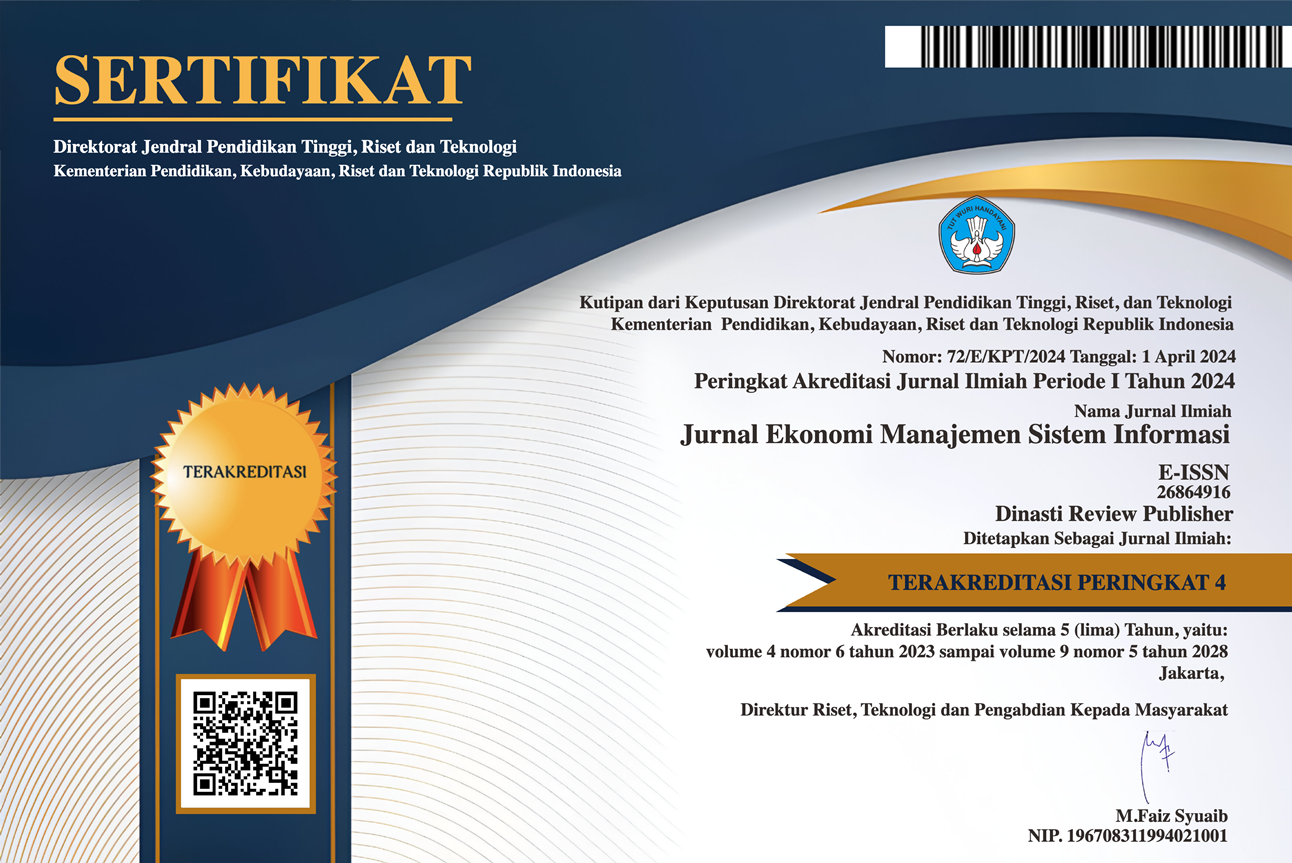Faktor-Faktor yang Mempengaruhi Inovasi dalam Sektor Penerbangan: Kapabilitas Sumber Daya Manusia, Kemajuan Teknologi, dan Prominensi Energi Bersih
DOI:
https://doi.org/10.31933/jemsi.v4i4.1503Keywords:
Innovation, Aviation, Human Resources, Technology Advancement, Clear EnergyAbstract
The significant changes in the international stage have raised new challenges for the aviation world. In order to cope with these challenges, the aviaton sector has been encouraged to apply innovation, both in its products and services. This article then aims to explain some factors that are influencing innovation in the aviation sector. The method used in this article is qualitative research method by focusing on the literature review. Therefore, the authors are focusing to analyze the secondary data to gain answers to research’s problems. The result shows that there are three factors influencing innovation in the aviation sector, namely human resource capability, technology advancement, and clear energy prominence. These three factors have a positive influence, so they can encourage the aviation sector to keep innovating.
References
Al-Shami, S. A., Alsuwaidi, A. K. M. S., & Akmal, S. (2022). The effect of entrepreneurial orientation on innovation performance in the airport industry through learning orientation and strategic alignment. Cogent Business & Management, 9(1), 1–21. https://doi.org/10.1080/23311975.2022.2095887
Alsuwaidi, A. K. M. S., Alshami, S. A., & Akmal, S. (2021). The Impact of Entrepreneurship towards Innovation in Airport Industry: The Double Mediation Framework of Strategic Alignment and Learning Orientation. Academy of Strategic Management Journal, 20(2), 1–19.
Bistline, J. E. T., & Young, D. T. (2020). Emissions impacts of future battery storage deployment on regional power systems. Applied Energy, 264, 114678. https://doi.org/10.1016/j.apenergy.2020.114678
Brelje, B., & Martins, J. R. (2019). Electric, Hybrid, and Turboelectric Fixed-Wing Aircraft: A Review of Concepts, Models, and Design Approaches. Progress in Aerospace Sciences,104, 1–19.
Caetano, M., & Alves, C. J. P. (2019). Innovation System in Air Transport Management. Journal of Information System and Technology Management, 16, 1–13. https://doi.org/10.4301/S1807-1775201916010
Cahyono, I. H., Cahyo, B. D., & Sukma, M. M. (2019). Analisis Skill pada Penggunaan Tools terhadap Keselamatan Kerja Aircraft Maintenance Technician. Prosiding Seminar Nasional Inovasi Teknologi Penerbangan (SNITP) Tahun 2019, 1–15.
Callaway, S. K., & Hong, P. (2016). Open network innovation in the age of complexity: case for small and medium enterprises. International Journal of Business Innovation and Research, 10(1), 65–86.
Cropley, A. (2022). Introduction to Qualitative Research Methods?: A practice-oriented introduction for students of psychology and education. 0–211. https://doi.org/10.13140/RG.2.1.3095.6888/1
Cui, Q., & Li, Y. (2015). The change trend and influencing factors of civil aviation safety efficiency: the case of Chinese airline companies. Journal of Safety Science, 75, 56–63.
Gordon, S., Adler, H., Day, J., & Sydnor, S. (2019). Perceived supervisor support: A study of select-service hotel employees. Journal of Hospitality and Tourism Management, 38, 82– 90. https://doi.org/10.1016/j. jhtm.2018.12.002
Hoang, L. N. Le, Thu, H. N. T., & Ho, V.-A. (2021). Fostering innovative behavior in the aviation industry: The role of perceived supervisor support and work group diversity. Problems and Perspectives in Management, 19(1), 163–176. https://doi.org/10.21511/ppm.19(1).2021.14
Hoenicke, P., Ghosh, D., Muhandes, A., Bhattacharya, S., Bauer, C., Kallo, J., & Willich, C. (2021). Power management control and delivery module for a hybrid electric aircraft using fuel cell and battery. Energy Conversion and Management, 244, 114445. https://doi.org/10.1016/j.enconman.2021.114445
Ilmudeen, A., Bao, Y., & Alharbi, I. M. (2019). How does business-IT strategic alignment dimension impact on organizational performance measures: Conjecture and empirical analysis. Journal of Enterprise Information Management, 32(3), 457–476. https://doi.org/10.1108/JEIM-09-2018-0197
Jaroensutiyotin, J., Wang, Z., Ling, B., & Chen, Y. (2019). Change leadership and individual innovative behavior in crisis contexts: An attentional perspective. Social Behavior and Personality: An International Journal, 47(4), 1–12.
Jonsson, N., & Hillesoy, F. (2020). Sustainable Solutions in the Aviation Industry: A Scenario analysis of electrified aircrafts, sustainable aviation fuels and carbon offsetting. KTH Industriel teknik och management.
Kaban, I. D. (2020). Analisa Inovasi Pelayanan Pengguna Jasa Penerbangan Melalui Airport Digital di Bandara Soekarno Hatta. Jurnal Manajemen Pendidikan Dan Ilmu Sosial, 1(1), 211–223. https://doi.org/10.38035/JMPIS
Kementerian Perhubungan Republik Indonesia. (2020). Model dan Strategi Pemulihan Bisnis Penerbangan Pasca Pandemi Covid-19.
Lee-Anant, C., & Monpanthong, P. (2021). Factors Influencing Airport Technology Selections in Each Service Touchpoint of Suvarnabhumi Airport, Thailand. Turkish Journal of Computer and Mathematics Education, 12(13), 3804–3816.
Luke, K.-H., Walther, J., & Waldchen, D. (2018). Innovation Management Methods in the Aviation Industry (Vol. 1, pp. 161–177). https://doi.org/10.1007/978-3-319-93408-2 Makhloufi, L., Laghouag, A. A., Sahli, A. A., & Belaid, F. (2021). Impact of entrepreneurial orientation on innovation capability: The mediating role of absorptive capability and organizational learning capabilities. Sustainability, 13(10), 5399. https://doi.org/10.3390/su13105399
Mohajan, H. K. (2018). Qualitative Research Methodology in Social Sciences and Related Subjects. Journal of Economic Development, Environment, and People, 7(1), 23–48.
Monica, R., & Krishnaveni, R. (2019). Enhancing innovative work behaviour through work engagement: examining the role of psychological empowerment and social support. International Journal of Business Innovation and Research, 20(4), 527–553.
Monteiro, A. P., Soares, A. M., & Rua, O. L. (2019). Linking intangible resources and entrepreneurial orientation to export performance: The mediating effect of dynamic capabilities. Journal of Innovation and Knowledge, 4(3), 179–187. https://doi.org/10.1016/j.jik.2019.04.001
Pereira, B. A., Lohmann, G., & Houghton, L. (2022). Technology trajectory in aviaton: Innovations leading to value creation (2000-2019). International Journal of Innovation Studies, 6(2022), 128–141. https://doi.org/10.1016/j.ijis.2022.05.001
Pereira, B., Lohmann, G., & Houghton, L. (2021). The Role of Collaboration in Innovation and Value Creation in the Aviation Industry. Journal of Creating Value, 7(1), 44–59. https://doi.org/10.1177/23949643211010588
Riwo-Abudho, M., Njanja, L. W., & Ochieng, I. (2013). Key Success Factors in Airlines: Overcoming the Challenges. European Journal of Business and Management, 5(30), 84– 89.
Sarigul, S. S., & Coskun, S. (2022). Effects of Innovation Strategies in the Aviation Industry. Uluslararasi Yonetim Akademisi Dergisi, 5(2), 365–380.
Singh, S., & Aggarwal, Y. (2021). In search of a consensus definition of innovation?: a qualitative synthesis of 208 definitions using grounded theory approach. Innovation: The European Journal of Social Science Research, 1–19. https://doi.org/10.1080/13511610.2021.1925526
Sitorus, B., & Sitorus, T. I. H. (2017). Pengembangan Automatic Dependent Surveillance Broadcast untuk Peningkatan Keselamatan Penerbangan. Jurnal Manajemen Transportasi & Logistik, 4(3), 303–312.
Türeli, N. ?., Durmaz, V., Sacide, Y., & Seda, S. (2019). An Analysis of Importance of Innovatice Behaviors of Ground Handling Human Resources in Ensuring Customer Satisfaction. Procedia Computer Science, 158(2019), 1077–1087. https://doi.org/10.1016/j.procs.2019.09.149
Downloads
Published
How to Cite
Issue
Section
License
Hak cipta :
Penulis yang mempublikasikan manuskripnya di jurnal ini menyetujui ketentuan berikut:
- Hak cipta pada setiap artikel adalah milik penulis.
- Penulis mengakui bahwa Jurnal Ekonomi Manajemen Sistem Informasi (JEMSI) berhak menjadi yang pertama menerbitkan dengan lisensi Creative Commons Attribution 4.0 International (Attribution 4.0 International CC BY 4.0) .
- Penulis dapat mengirimkan artikel secara terpisah, mengatur distribusi non-eksklusif manuskrip yang telah diterbitkan dalam jurnal ini ke versi lain (misalnya, dikirim ke repositori institusi penulis, publikasi ke dalam buku, dll.), dengan mengakui bahwa manuskrip telah diterbitkan pertama kali di Jurnal Ekonomi Manajemen Sistem Informasi (JEMSI).











































































